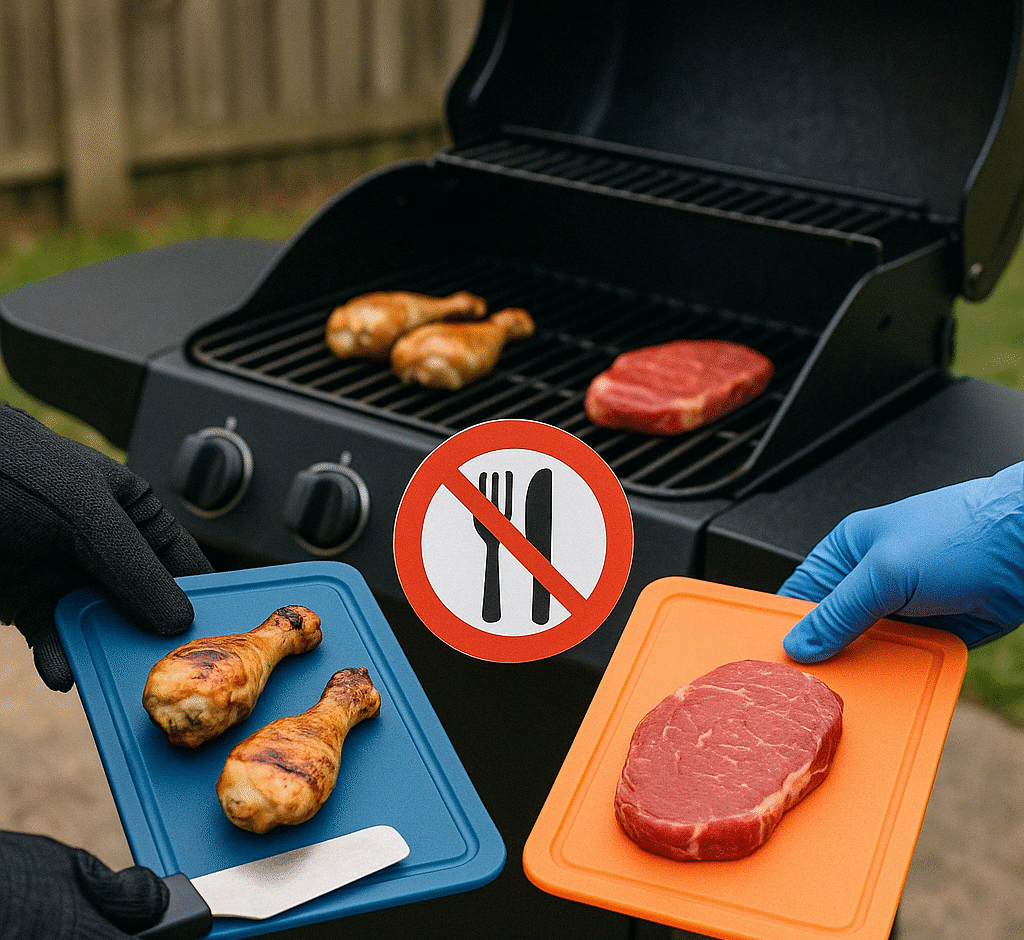
Cross-contamination can turn your BBQ from a feast into a fiasco. Learn the essential food handling tips that keep your cookout safe and bacteria-free.
The Real Danger Isn’t the Fire — It’s What You Can’t See
When people think about BBQ safety, they usually picture fire hazards. But one of the biggest risks is completely invisible: bacteria. Cross-contamination happens when raw meat juices touch cooked foods, utensils, or surfaces — and it can lead to serious foodborne illnesses.
Luckily, with a few smart habits and the right gear, you can protect your guests (and yourself) from that unwanted side of BBQ.
Separate Raw and Cooked — Always
One of the golden rules of grilling: what’s raw never touches what’s cooked.
Here’s how to enforce that:
- Use separate cutting boards for raw meat and veggies
- Have two sets of tongs and spatulas — one for raw handling, one for cooked food
- Never put cooked meat back on the same plate that held raw meat
- Keep raw meats in sealed containers or bags until ready to grill
This simple separation reduces your risk of spreading harmful bacteria like Salmonella, E. coli, and Listeria.
Chill It Until You Grill It
Bacteria thrive in the “danger zone” — between 40°F and 140°F. Leaving meats out too long before cooking can invite contamination.
- Only take raw meat out of the fridge or cooler when you’re ready to grill
- Use an insulated cooler with plenty of ice or ice packs
- Don’t leave raw meat sitting out in the sun, even “just for a few minutes”
If food’s been sitting out for over two hours (or one hour in 90°F+ heat), toss it.
Clean Tools = Safe Grilling
Washing your hands and cleaning your tools may seem obvious, but during a busy BBQ, it’s easy to forget.
- Wash hands with soap and water before and after handling raw meat
- Disinfect grill tools that touched raw meat before reusing
- Keep disinfecting wipes or a basin of soapy water nearby when prepping outdoors
- Sanitize thermometer probes between uses
The goal is to keep bacteria from sneaking their way onto your plate — or anyone else’s.
Use a Meat Thermometer (Yes, Every Time)
Don’t trust color or texture to tell you when food’s done — it’s not reliable. The only way to know it’s safe is to check the internal temperature:
- Poultry: 165°F
- Ground beef/pork: 160°F
- Whole cuts of beef, pork, lamb: 145°F + rest for 3 minutes
- Fish: 145°F
Use an instant-read digital thermometer and make it part of your grilling ritual.
Watch the Marinade
Marinades can pack flavor — but they can also pack bacteria. If you’ve marinated raw meat, never reuse the leftover marinade on cooked food unless you boil it first for at least 3 minutes.
If you want to baste during or after grilling, set some marinade aside before adding it to the raw meat.
Serve with Clean Surfaces
After all that work at the grill, don’t ruin it at the serving table. Make sure:
- Serving platters and utensils are clean
- Foods are covered until ready to serve (especially in outdoor settings)
- Cold dishes are kept chilled and hot dishes stay warm
Safety Is the Secret Ingredient
You could be a master of rubs, sauces, and searing — but if cross-contamination sneaks in, all that effort goes to waste. Good food handling habits are the secret weapon of any true grill master. Keep it clean, keep it separate, and you’ll keep everyone happy and healthy.
